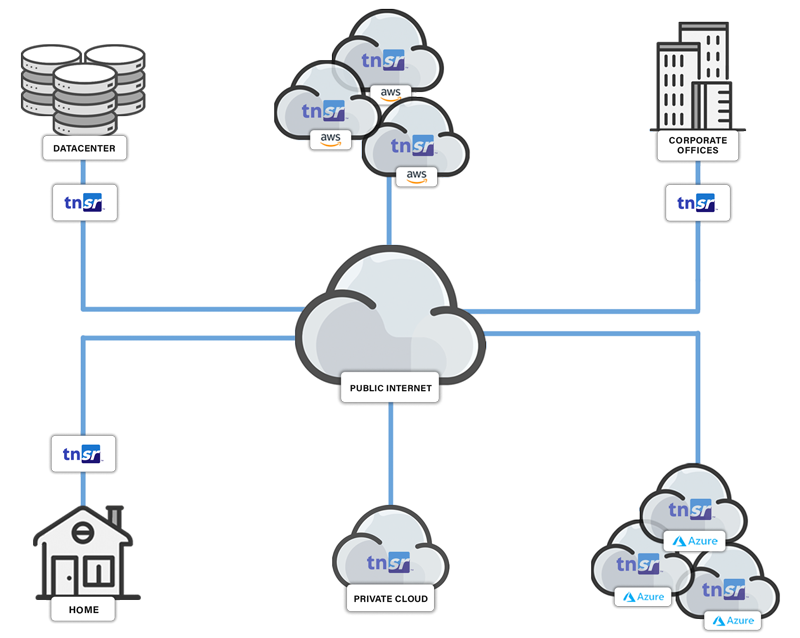It’s All in the Applications
TNSR provides stellar packet per second and gigabit per second performance for the most demanding secure networking applications.

What is High-Speed Cloud Connectivity?
Today’s Cloud Service Providers (CSPs) provide alternatives to the Internet for accessing cloud services from business remote offices, corporate headquarters, or premises-based data centers. These high-speed links provide customers with lower latency, more secure connections to cloud workloads than the traditional Internet. Examples include AWS Direct Connect and Azure ExpressRoute. But these services typically terminate at an Internet Service Provider (ISP) co-location point. There is still a requirement for a high-speed connection from customer premises to the ISP, and oftentimes faster connections between intra-cloud Virtual Private Clouds (VPCs).
TNSR is the perfect solution for connecting to CSP on-ramps or between VPCs - offering compelling scalability and economics compared to a new purchase or upgrade of a legacy router.

Static Routing
Dynamic Routing
BGP
OSPF
ECMP
Static ARP
BFD
IPsec
SPAN
ERSPAN
VXLAN
GRE
802.1q
802.1ad VLAN (QinQ)
LACP
LAG
Cloud Connectivity Features
Static Routing
Static routing relies upon manually-configured routing entry rather than information from dynamic routing traffic. Static routes are fixed and do not change if the network is changed or reconfigured. Static routing and dynamic routing are not mutually exclusive.
More information can be found in our documentation.
Dynamic Routing
Static routing relies upon manually-configured routing entry rather than information from dynamic routing traffic. Static routes are fixed and do not change if the network is changed or reconfigured. Static routing and dynamic routing are not mutually exclusive.
More information can be found in our documentation.
BGP
Border Gateway Protocol (BGP), the routing protocol used by the global internet, finds the best route path by weighing the latest network conditions based on reachability and routing information.
More information can be found in our documentation.
OSPF
Open Shortest Path First (OSPF) is an interior gateway protocol that uses a link state routing algorithm to find the best path between a source and destination router. TNSR supports both OSPF v2 (OSPF) and OSPF v3 (OSPF6).
More information can be found in our documentation.
ECMP
Equal-cost multi-path (ECMP) is a dynamic routing protocol where packet forwarding to a single destination can occur over multiple best paths with equal routing priority.
More information can be found in our documentation.
Static ARP
Static Address Resolution Protocol (Static ARP) is used to manually map IP network addresses to the hardware MAC address so they are retained in the router cache on a permanent basis.
More information can be found in our documentation.
BFD
Bidirectional Forwarding Detection (BFD) is a protocol that can detect link failures within milliseconds, or even microseconds.
More information can be found in our documentation.
IPsec
IPsec is a group of protocols used together to set up encrypted connections between devices. It helps keep data sent over public networks secure. IPsec is often used to set up VPNs, where it both encrypts IP packets and authenticates the source from where the packets originated.
More information can be found in our documentation.
SPAN
Switched Port Analyzer (SPAN) enables all packets that come into or out of an interface (SPAN source) to be copied (mirrored) to a local port or CPU (SPAN destination) for monitoring. The original packet is still switched.
More information can be found in our documentation.
ERSPAN
Encapsulated Remote SPAN (ERSPAN) enables mirrored packets to be sent to a monitoring node located anywhere across the routed network. The original Layer 2 packet is encapsulated with GRE for IP delivery.
More information can be found in our documentation.
VXLAN
Virtual Extensible LAN (VXLAN) is a network virtualization technology that attempts to address the scalability problems associated with large cloud computing deployments. VxLAN virtually extends a Layer 2 segment across a Layer 3 network infrastructure by encapsulating Layer 2 Ethernet frames inside a VXLAN packet that includes an IP address. VxLAN is similar to VLAN, which also encapsulates Layer 2 frames and segments networks. The main difference is that VXLAN encapsulates the MAC in UDP, and can scale up to 16 million VxLAN segments, where VLAN uses the tag on the Layer 2 frame for encapsulation and can only scale to 4,000 VLANs.
More information can be found in our documentation.
GRE
Generic Routing Encapsulation (GRE) wraps (encapsulates) one data packet within another - to create a direct point-to-point connection across a network - to simplify connections between separate networks.
More information can be found in our documentation.
802.1q
802.1q tunneling enables the use of a single VLAN to support multiple customer VLANs, i.e., service provider switches use a single service provider VLAN to carry all customer VLANs as opposed to directly carrying all customer VLANs independently.
More information can be found in our documentation.
802.1ad VLAN (QinQ)
802.1ad VLAN (QinQ) enables VLAN traffic to be carried over Ethernet. Based upon 802.1Q, QinQ allows VLANs to be nested by adding two tags to each frame instead of one, i.e., VLAN stacking or QinQ). QinQ also makes it possible to have more than the 4094 separate VLANs in a 802.1q tunnel.
More information can be found in our documentation.
LACP
Link Aggregation Control Protocol (LACP) is a bonding interface used to aggregate one or more physical ethernet interfaces to form a logical point-to-point link, referred to as a Link Aggregation Group (LAG), virtual link, or bundle.
More information can be found in our documentation.
LAG
Link Aggregation Group (LAG) allows a router to treat multiple physical links as a single logical link.
More information can be found in our documentation.
Who Needs High-Speed Cloud Connectivity?

Businesses, Educational Institutions and Government Agencies
Any business, educational institution, or government agency looking for high-speed data connections from campus, office or data center to a CSP where third-party applications, hosted applications, or other workloads reside.

Service Providers
Internet Service Providers (ISPs) looking to offer end customers 1 Gbps, 10 Gbps, 40 Gbps or higher WAN uplinks from premises to CSP high-speed links.
Where Should High-Speed Cloud Connectivity Be Deployed?
The public internet offers a convenient way to deliver cloud-based applications to employees, partners and customers. But securely connecting a few gigabits or more can quickly get expensive. TNSR provides consistent, fast, high-quality access to cloud applications and workloads from homes, branch offices, corporate locations, data centers, and more.

What Makes TNSR a Great High-Speed Cloud Connectivity Solution?
High Throughput
- Leverages Vector Packet Processing (VPP) to improve packet processing performance one to two orders of magnitude over kernel-based processing solutions
- Performance scales quickly and easily simply by adding cores
Feature Rich
- Bridging, Static Routing, Dynamic Routing, BGP, OSPF, ECMP, BFD, VRF and more
- Integrates VPP, DPDK, FRR, strongSwan, and Clixon open source technologies and more into a turnkey, ready to use commercial product
- Made secure through robust Routed IPsec site-to-site capabilities
Easily Scalable
- Scale out with appliances, virtual machines or cloud instances
- Scale up by increasing bandwidth per instance to the limit of hardware capabilities, no license constraints
- Leverage crypto offload for additional performance scale up
Excellent overall solution value
- Unbeatable packet processing price-performance for cloud connectivity applications
- No feature, bandwidth or other incremental licensing charges
- Leverages the most advanced open-source technologies
- Commercial subscriptions include the full benefit of seasoned global support specialists

%201.png?width=302&name=Netgate%20Logo%20PMS%20(horizontal)%201.png)
